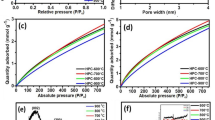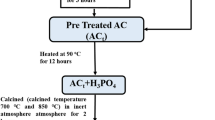Abstract
Nitrogen-doped porous carbon plates have been prepared by simple and cost-effective pyrolysis carbonization of an easily available biomass-fallen camellia flower and followed by alkali activation. As-prepared nitrogen-doped porous carbon (aNPCP3) possesses a high specific surface area of 2318 m2 g−1 and abundant micro/meso-pores. As a result, the aNPCP3 samples have been demonstrated to be electrodes for supercapacitors, displaying a high specific capacitance of 354 F g−1 at a current density of 0.2 A g−1 and excellent cycling stability. Further, the aNPCP3 samples used as sulfur host materials for lithium-sulfur batteries exhibit a high capacity of 1210 mAh g−1 and good cycling stability with a small capacity decay of about 0.1 % per cycle. Interestingly, it is found that their electrochemical performances are dependent on their specific surface area, pore structure, and heteroatom-doping content and type of carbon materials to a large extent. Cheapness, convenient resource, and good performance make these electrode materials displaying huge potential in cost-effective high-performance energy storage devices.









Similar content being viewed by others
References
Candelaria SL, Shao YY, Zhou W (2012) Nanostructured carbon for energy storage and conversion. Nano Energy 1:195–220
Merlet C, Rotenberg B, Madden PA, Taberna PL, Simon P, Gogotsi Y, Salanne M (2012) On the molecular origin of supercapacitance in nanoporous carbon electrodes. Nat Mater 11:306–310
Schuster J, He G, Mandlmeier B, Yim T, Lee KT, Bein T, Nazar LF (2012) Spherical ordered mesoporous carbon nanoparticles with high porosity for lithium-sulfur batteries. Angew Chem Int Ed 51:3591–3595
Liang C, Li Z, Dai S (2008) Mesoporous carbon materials: synthesis and modification. Angew Chem Int Ed 47:3696–3717
Wang KX, Zhang JN, Xia W, Zou RQ, Guo JH, Gao ZM, Yan WF, Guo SJ, Xu Q (2015) A dual templating route to three-dimensionally ordered mesoporous carbon nanonetworks: tuning the mesopore type for electrochemical performance optimization. J Mater Chem A 3:18867–18873
Chen XA, Xiao ZB, Ning XT, Liu Z, Yang Z, Zou C, Wang S, Chen XH, Chen Y, Huang SM (2014) Sulfur-impregnated, sandwich-type, hybrid carbon nanosheets with hierarchical porous structure for high-performance lithium-sulfur batteries. Adv Energy Mater 4:1301988
Tanaka S, Fujimoto H, Denayer JFM, Miyamoto M, Oumi Y, Miyake Y (2015) Surface modification of soft-templated ordered mesoporous carbon for electrochemical supercapacitors. Microporous and Mesoporous Mater 217:141–149
Deng YF, Xie Y, Zou KX, Ji XL (2016) Review on recent advances in nitrogen-doped carbons: preparations and applications in supercapacitors. J Mater Chem A 4:1144–1173
Li B, Dai F, Xiao QF, Yang L, Shen JM, Zhang CM, Cai M (2016) Nitrogen-doped activated carbon for a high energy hybrid supercapacitor. Energy Environ Sci 9:102–106
Lin TQ, Chen W, Liu FX, Yang CY, Bi H, Xu FF, Huang FQ (2015) Nitrogen-doped mesoporous carbon of extraordinary capacitance for electrochemical energy storage. Science 350:1508–1513
Zhao J, Lai HW, Lyu ZY, Jiang YF, Xie K, Wang XZ, Wu Q, Yang LJ, Jin Z, Ma YW, Liu J, Hu Z (2015) Hydrophilic hierarchical nitrogen-doped carbon nanocages for ultrahigh supercapacitive performance. Adv Mater 27:3541–3545
Song JX, Yu ZX, Gordin ML, Wang DH (2016) Advanced sulfur cathode enabled by highly crumpled nitrogen-doped graphene sheets for high-energy-density lithium-sulfur batteries. Nano Lett 16:864–870
Xiao S, Liu SH, Zhang JQ, Wang Y (2015) Polyurethane-derived N-doped porous carbon with interconnected sheet-like structure as polysulfide reservoir for lithium sulfur batteries. J Power Sources 293:119–126
Horikawa T, Sakao N, Sekida T, Hayashi J, Do D, Katoh M (2012) Preparation of nitrogen-doped porous carlbon by ammonia gas treatment and the effects of N-doping on water adsorption. Carbon 50:1833–1842
Wang JC, Ma RG, Zhou Y, Liu Q (2015) A facile nanocasting strategy to nitrogen-doped porous carbon monolith by treatment with ammonia for efficient oxygen reduction. J Mater Chem A 3:12836–12844
Kota M, Yu X, Yeon SH, Cheong HW, Park HS (2016) Ice-templated three dimensional nitrogen doped graphene for enhanced supercapacitor performance. J Power Source 303:372–378
Xu JT, Wang M, Wickramaratne NP, Jaroniec M, Dou SX, Dai LM (2015) High-performance sodium ion batteries based on a 3D anode from nitrogen-doped graphene foams. Adv Mater 27:2042–2048
Ma ZL, Guo CZ, Yin YJ, Zhang YQ, Wu HJ, Chen CG (2015) The use of cheap polyaniline and melamine co-modified carbon nanotubes as active and stable catalysts for oxygen reduction reaction in alkaline medium. Electrochim Acta 160:357–362
Zhang JT, Zhao ZH, Xia ZH, Dai LM (2015) A metal-free bifunctional electrocatalyst for oxygen reduction and oxygen evolution reactions. Nat Nanotechnol 10:444–452
Zhu JH, Yang J, Miao RR, Yao ZQ, Zhuang XD, Feng XL (2016) Nitrogen-enriched, ordered mesoporous carbons for potential electrochemical energy storage. J Mater Chem A 4:2286–2292
Yang TZ, Qian T, Wang MF, Shen XW, Xu N, Sun ZZ, Yan CL (2016) A sustainable route from biomass byproduct okara to high content nitrogen-doped carbon sheets for efficient sodium ion batteries. Adv Mater 28:539–545
Ma YZ, Yu BJ, Guo Y, Wang CY (2016) Facile synthesis of biomass-derived hierarchical porous carbon microbeads for supercapacitors. J Solid State Electrochem 20:2231–2240
Tao XY, Zhang JT, Xia Y, Huang H, Du J, Xiao H, Zhang WK, Gan YP (2014) Bio-inspired fabrication of carbon nanotiles for high performance cathode of Li-S batteries. J Mater Chem A 2:2290–2296
Geng Z, Xiao QF, Wang DB, Yi GH, Xu ZG, Li B, Zhang CM (2016) Improved electrochemical performance of biomass-derived nanoporous carbon/sulfur composites cathode for lithium-sulfur batteries by nitrogen doping. Electrochim Acta 202:131–139
Shang TX, Jin XJ (2016) Waste particleboard-derived nitrogen-containing activated carbon through KOH activation for supercapacitors. J Solid State Electrochem 20:2029–2036
Ma GF, Yang Q, Sun KJ, Peng H, Ran FT, Zhao XL, Lei ZQ (2015) Nitrogen-doped porous carbon derived from biomass waste for high-performance supercapacitor. Bioresour Technol 197:137–142
Schipper F, Vizintin A, Ren JW, Dominko R, Fellinger TP (2015) Biomass-derived heteroatom-doped carbon aerogels from a salt melt sol-gel synthesis and their performance in Li-S batteries. Chem Sus Chem 8:3077–3083
Wang H, Cui XX, Zhao XG, Gao S, Zhao JN, Yuan ZL (2015) Differences of biochemical constituents and contents of eight cultivars flowers of Camellia sinensis. J Essent Oil Bear Pl 18:320–328
Wang L, Xu RJ, Hu B, Li W, Sun Y, Tu YY, Zeng XX (2010) Analysis of free amino acids in Chinese teas and flower of tea plant by high performance liquid chromatography combined with solid-phase extraction. Food Chem 123:1259–1266
Zhu YW, Murali S, Stoller MD, Ganesh KJ, Cai WW, Ferreira PJ, Pirkle A, Wallace RM, Cychosz KA, Thommes M, Su D, Stach EA, Ruoff RS (2011) Carbon-based supercapacitors produced by activation of grapheme. Science 332:1537–1541
Chang JL, Gao ZY, Wang XR, Wu DP, Xu F, Wang X, Guo YM, Jiang K (2015) Activated porous carbon prepared from paulownia flower for high performance supercapacitor electrodes. Electrochim Acta 157:290–298
Qu JY, Geng C, Lv SY, Shao GH, Ma SY, Wu MB (2015) Nitrogen, oxygen and phosphorus decorated porous carbons derived from shrimp shells for supercapacitors. Electrochim Acta 176:982–988
Raymundo-Piñero E, Leroux F, Béguin F (2006) A high-performance carbon for supercapacitors obtained by carbonization of a seaweed biopolymer. Adv Mater 18:1877–1882
Li Z, Huang YM, Yuan LX, Hao ZX, Huang YH (2015) Status and prospects in sulfur-carbon composites as cathode materials for rechargeable lithium-sulfur batteries. Carbon 92:41–63
Xin S, Gu L, Zhao NH, Yin YX, Zhou LJ, Guo YG, Wan LJ (2012) Smaller sulfur molecules promise better lithium-sulfur batteries. J Am Chem Soc 134:18510–18513
Li J, Qin FR, Zhang LY, Zhang K, Li Q, Lai YQ, Zhang ZA, Fang J (2014) Mesoporous carbon from biomass: one-pot synthesis and application for Li-S batteries. J Mater Chem A 2:13916–13922
Acknowledgments
The work was supported in part by grants from National Nature Science Foundation of China (51402217 and 51420105002), Zhejiang Science and Technology Project (2014C31155), Graduate Innovation Fund of Wenzhou university (3162015034).
Author information
Authors and Affiliations
Corresponding authors
Electronic supplementary material
ESM 1
(DOCX 981 kb)
Rights and permissions
About this article
Cite this article
Guo, D., Zheng, C., Deng, W. et al. Nitrogen-doped porous carbon plates derived from fallen camellia flower for electrochemical energy storage. J Solid State Electrochem 21, 1165–1174 (2017). https://doi.org/10.1007/s10008-016-3474-2
Received:
Revised:
Accepted:
Published:
Issue Date:
DOI: https://doi.org/10.1007/s10008-016-3474-2




